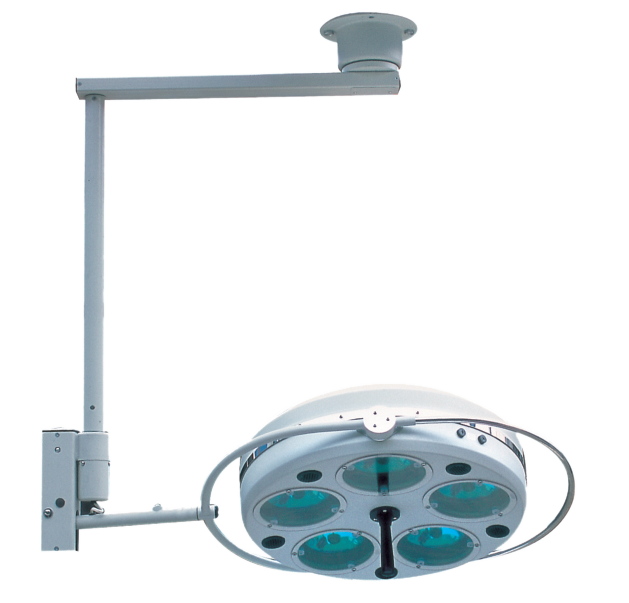
Hanging, tungsten halogen bulb
Halogen Bulbs are mainly used in hospital operating rooms and ambulatory surgery centers and also be used in various locations throughout the facility to provide high quality lighting for procedures. They are a cheaper alternative that is not only easier to install but also has a longer life expectancy.
Hanging, tungsten halogen bulb
| Type: | Package Size: | G.W.: | N.W.: |
|---|---|---|---|
| NML735001 NML735002 |
80x77x34 5 (cm) | 41(kg) | 21(kg) |
| NML735003 NML735004 |
114x67x36 (cm) | 59(kg) | 35(kg) |
| Main Technical Data | |
|---|---|
| llluminance | NML735002 NMCL735004≥60000Lx NML735001 NML735003≥50000Lx |
| Color Temperature | 4300±200k |
| Color rendering index | Ra≥90 |
| Mains Voltage | -220V±22V 50Hz±1Hz -110V±11V 60Hz±1Hz |
| Rated Voltage Of Bulb | 24V |
| Rated Power Of Bulb | 25W |
A halogen bulb is a type of incandescent light bulb that uses a halogen to increase the bulb's efficiency and lifespan. The halogen allows the electric current to flow more freely through the filament, which in turn produces more light. Halogen bulbs also have a higher color rendering index than regular incandescent bulbs, meaning they produce a more natural-looking light. Hospitals rely on halogen bulbs for a number of reasons. First and foremost, they provide an essential source of lighting. Second, halogen bulbs are very efficient, meaning they use less energy and last longer than other types of bulbs. Finally, halogen bulbs produce a natural-looking light that is ideal for hospital settings.
There are three types of halogen bulbs- tungsten halogen, quartz halogen, and metal halide. Tungsten halogen bulbs are the most common type of halogens. They contain a small amount of a gas, typically iodine or bromine, and a tungsten filament. The gas enables the bulb to emit a bright white light. Quartz halogen bulbs are similar to tungsten halogens but contain a quartz envelope instead of a glass envelope. Metal halide bulbs contain a mercury vapor and metal halides. They produce a bluish-white light and are often used in high-intensity discharge (HID) lighting fixtures.
There are many different types of lighting that are used in hospitals, but halogen bulbs are one of the most essential. Halogen bulbs provide a bright, white light that is perfect for medical procedures and examinations. However, there are some pros and cons to using halogen bulbs in hospitals. One of the biggest pros of halogen bulbs is that they are very energy efficient. They use less energy than traditional incandescent bulbs, which means that hospitals can save money on their electricity bills. Additionally, halogen bulbs last much longer than incandescent bulbs, so hospitals will not have to replace them as often. However, there are some cons to using halogen bulbs as well. One of the biggest disadvantages is that they can be very hot to the touch. If someone accidentally touches a halogen bulb, they could potentially get burned. Additionally, if a hospital is not properly ventilated, the heat from the halogen bulbs could make the environment too hot for patients and staff members.
There are many reasons why halogen bulbs are essential lighting providers in hospitals. One reason is that they produce a very high light output. This is important in hospital settings where there is often a need for bright, clear light. Additionally, halogen bulbs have a long lifespan. This means that they can provide reliable lighting for a long period of time without needing to be replaced frequently. Finally, halogen bulbs are very energy efficient. This is important in hospital settings where there is often a need to conserve energy and resources.
As we all know, halogen bulbs are commonly used in hospitals. But what we don't know is that they are also used in other places as well. Here are some examples of other places where halogen bulbs may be used:
1. Nursing homes: Nursing homes rely on halogen bulbs to provide the essential lighting that their residents need.
2. Assisted living facilities: Assisted living facilities also use halogen bulbs to provide the necessary lighting for their residents.
3. Senior citizen centers: Senior citizen centers use halogen bulbs to provide bright, comfortable lighting for their members.
4. Rehabilitation centers: Rehabilitation centers use halogen bulbs to help their patients recover from injuries and illnesses.
5. Doctors' offices: Doctors' offices use halogen bulbs to create a bright, inviting environment for their patients.